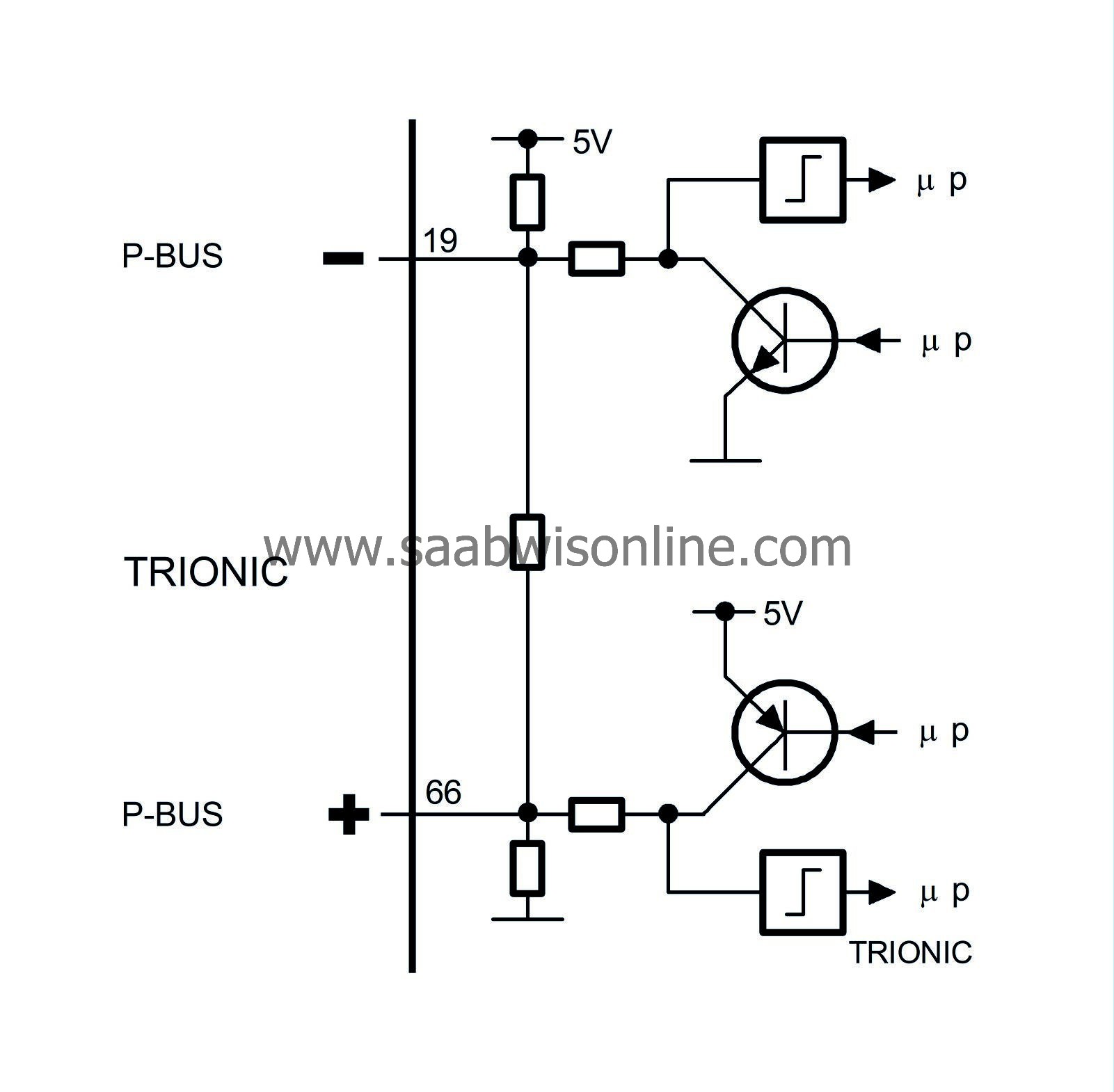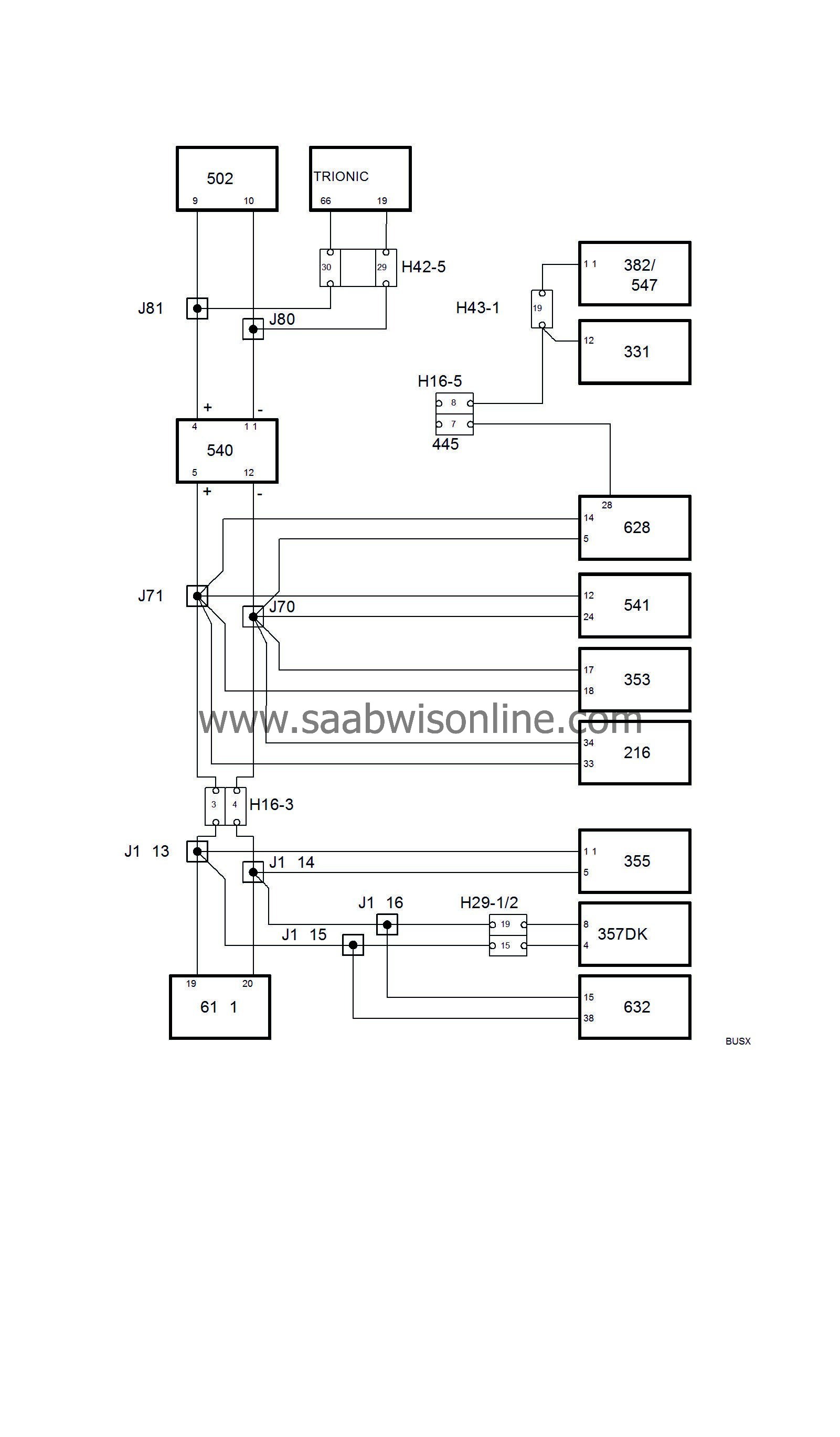Bus communication
| Bus communication |
| • |
Control module, Trionic T7 (608)
|
|
| • |
Control module, TCM (502)
|
|
| • |
Control module, MIU (540)
|
|
| • |
Control module, DICE (628)
|
|
| • |
Data link connector (445)
|
|
| • |
Control module, SID (541)
|
|
| • |
Control module, Audio (353)
|
|
| • |
Control module, ACC (216)
|
|
| • |
Control module, CD-changer (355)
|
|
| • |
Control module, PSM (357)
|
|
| • |
Control module, TWICE (632)
|
|
| • |
Control module, PMM (611)
|
|
| • |
Control module ABS (547), TC/ABS (382)
|
|
| • |
Control module, Airbag (331)
|
|
| P bus and I bus |

All the control modules in the Saab 9-5 are connected to the bus with the exception of ABS, TC/ABS and SRS.
The bus is divided into the Powertrain bus (P bus) and the Instrument bus (I bus). Both buses are connected to the main instrument unit (MIU). The buses are electrically isolated from each other.
Data transfer is 10 times faster on the P bus than on the I bus.
All the information transmitted by one of the control modules is available to all the other control modules connected to the bus. MIU is responsible for making the information that is available on one bus also available on the other bus.
The control modules transmit information on the bus at regular intervals. The time between two transmissions depends on the information being sent and varies between 10 milliseconds (0.010 seconds) and one second. Information is also transmitted by the control modules each time the information changes.
Information between the control modules is transferred through two leads, BUS + (green lead) and BUS- (white lead). The two leads are twisted to reduce sensitivity to electrical interference.
| Diagnostics |
In a bus system, it is necessary for all the units to be able to communicate with each other. For example, the engine cannot be started unless Trionic T7 can receive immobilizer information transmitted by TWICE.
Permanent bus faults
All communications between the diagnostic tool and systems on the bus take place via DICE. Irrespective of which system is being contacted, the diagnostic tool, with the help of DICE, will make sure that all the systems on the bus are active and communicating. The diagnostic tool will indicate any control modules missing from the bus. This means that all the control modules are communicating correctly on the bus unless the diagnostic tool warns otherwise.Intermittent bus faults
Trionic continuously checks to see that TCM and MIU are communicating correctly. Diagnostic trouble codes will be generated if an intermittent fault should occur in the bus communication. The cause of the fault could be that the power supply or one of the bus leads to a control module is absent.| Control module absent | Diagnostic trouble code |
|
TCM
|
P1923
|
|
MIU
|
P1908
|
| Trionic T7 uses the following information: |
| Information | Sensor system | Description |
|
Maximum permissible torque (Nm)
|
TCM
|
TCM sends maximum permissible torque, unit Nm. The value is used in the air mass control for engine torque limitation.
|
|
Sport position selected (ON/OFF)
|
TCM
|
TCM sends sport position, unit ON/OFF. The value is used in the air mass control to correct the conversion of the pedal position to requested air mass/combustion.
|
|
Selector lever position, automatic transmission (PRND321)
|
TCM
|
TCM sends selector lever position, unit PRND321. The value is used in the air mass control for idle speed control.
|
|
Vehicle speed, rear left wheel (km/h)
|
MIU
|
MIU sends speed, unit km/h. The value is used by cruise control and as a substitute value if the speed signal from ABS disappears.
|
|
Reverse gear selected (ON/OFF)
|
DICE
|
DICE sends reverse gear engaged, unit ON/OFF. The value is used to determine if first gear or reverse gear is engaged as the gear ratio is not enough to distinguish between them.
|
|
A/C request (ON/OFF)
|
DICE
|
DICE sends A/C request, unit ON/OFF. The value is used in the air mass control, compensation, to compensate for the increase in load. The control module also activates the A/C relay.
|
|
A/C pressure, high-pressure side (bar)
|
DICE
|
DICE sends pressure, unit bar. The value is used in the air mass control, compensation, to calculate the increase in load before the A/C compressor is activated.
|
|
Current consumption (A)
|
DICE
|
DICE sends the calculated current consumption of the electrically heated rear window and radiator fans just before they are activated, unit A. The value is used in the air mass control, compensation, to compensate for the increase in load.
|
|
Fast idling speed (ON/OFF)
|
DICE
|
DICE sends fast idling speed, unit ON/OFF. ON is sent if the radiator fan is activated for high-speed during the present driving cycle. The value is used in the idle speed control.
|
|
Brake lights (ON/OFF)
|
TWICE
|
TWICE sends brake lights, unit ON/OFF. The value is used in the air mass control for engine torque limitation.
|
|
Fuel level (Litres)
|
MIU
|
MIU sends fuel level, unit Litres. The value is used in the on-board diagnostics to generate special diagnostic trouble codes during misfiring in conjunction with low fuel levels and for adaptation of the tank pressure sensor value.
|
|
CHECK ENGINE Request (ON/OFF)
|
TCM
|
TCM sends request, unit ON/OFF. The value is used in the on-board diagnostics to turn on the CHECK ENGINE lamp when ON is sent. Diagnostic trouble code P1624 is generated to indicate a fault in TCM.
|
|
Immobilizer (ON/OFF)
|
TWICE
|
TWICE sends immobilizer, unit ON/OFF. The value is used in the fuel injection to activate fuel shut-off.
|
|
Ignition +50 (ON/OFF)
|
DICE
|
DICE sends +50, unit ON/OFF. The value is used for diagnosis of the crankshaft position sensor.
|
|
Diagnostics
|
DICE/ diagnostic tool
|
The diagnostic tool sends a diagnostics request via DICE, no unit. The value is used to respond to the current request.
|
| Trionic T7 transmits the following information: |
| Information | User system | |
|
Engine torque (Nm)
|
TCM
|
Current air mass/combustion converted to engine torque, unit Nm. The value is used by TCM.
|
|
Accelerator pedal position (%)
|
TCM
|
The highest of the air mass/combustion values requested from the accelerator pedal position or cruise control is selected. The value is converted to a corresponding accelerator pedal position, unit percent. The value is used by TCM.
|
|
Kickdown (ON/OFF)
|
TCM
|
When the voltage from pedal potentiometer 1 corresponds with the kickdown position (below 1.50 V), kickdown ON, unit ON/OFF is sent. The value is used by TCM.
|
|
Engine speed (rpm)
|
MIU, TCM and ACC
|
The current engine speed is sent, unit rpm. The value is used by TCM, ACC and MIU.
|
|
Engine coolant temperature (°C)
|
MIU, DICE and ACC
|
Current temperature is sent, unit °C. The value is used by ACC, MIU and DICE.
|
|
Engine running (ON/OFF)
|
ACC, DICE
|
ON, unit ON/OFF is sent when the engine speed exceeds 650 rpm. The value is used by ACC and DICE.
|
|
Tighten fuel filler cap (ON/OFF)
|
SID
|
ON, unit ON/OFF, is sent if the tank integrity diagnosis indicates a leak. The value is used by SID.
|
|
CHECK ENGINE (ON/OFF)
|
MIU
|
ON, unit ON/OFF, is sent when the on-board diagnostics reports that the lamp is to be turned on. The value is used by MIU.
|
|
SHIFT UP (ON/OFF)
|
MIU
|
ON, unit ON/OFF, is sent at low loads and high engine speeds and at very high engine speeds irrespective of load. The value is used by MIU.
|
|
CRUISE lamp (ON/OFF)
|
MIU
|
ON, unit ON/OFF, is sent when cruise control is activated with the switch. The value is used by MIU.
|
|
Fuel consumed since start (ml)
|
MIU
|
When the ignition is switched on, the value is 0 ml and is then accumulated for each injection, unit ml. The value is used by MIU.
|
|
Diagnostics
|
DICE/ diagnostic tool
|
Trionic T7 responds to the diagnostics request from the diagnostic tool via DICE, no unit.
|



